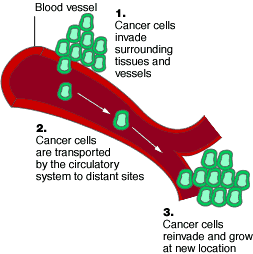  |
|
Metastasis or "mets":
How Cancer Spreads
metastasis (meh-TAS-ta-sis): The spread of cancer from one part of the body to
another. Tumors formed from cells that have spread are called "secondary
tumors" and contain cells that are like those in the original (primary) tumor. The plural is metastases.
(further resources at the end of this article)
Tumors are called "malignant"
because they have the ability to invade normal tissues (replacing
healthy cells with cancer cells) and to metastasize (spread)
to other parts of the body. Death from cancer often comes not
from the primary site (where the cancer first began) but from
the metastases [also known as "mets"]. For example, a patient with stomach cancer may
actually die from liver failure after the cancer has spread to
that organ.
When a certain type of cancer spreads to
another part of the body, it does not change its type. For example,
if a person with a lymphoma develops a tumor in the lung which
is a metastasis from this lymphoma, the tumor growing in the
lung has the same characteristics as the lymphoma. It does not
represent a new lung cancer of the type which would develop if
the cancer was to start in, or to be "primary" in the
lung. It is important to understand this as the treatment that
will be effective against the metastasis will be the same treatment
that will be used for the primary lymphoma. This is why it is
most important for the doctors treating a patient to be able
to establish the primary site at which any cancer originated.
Metastases takes place in many ways: through
the lymphatic system, through the bloodstream, by spreading through
body spaces such as the bronchi or abdominal cavity, or through
implantation.
The most common way for cancer to spread
is through the lymphatic system. This process is called "embolization".
The lymph system has its own channels that circulate throughout
the body, similar to the veins and arteries of the bloodstream.
These channel are very small and carry a tissue fluid called
lymph throughout the body.
Often when a solid tumor is removed by
surgery, the surgeon will remove not only the tumor but the neighboring
lymph glands, even though there is no visible sign of cancer
in those glands. This is done as a precautionary measure, because
if even one cell has broken away from the tumor and lodged in
the lymphatic system, the cancer could continue growing and metastasizing.
Cancer can also metastasize through the
bloodstream. Cancer cells, like healthy cells, must have a blood
 supply in order to live, so all cancer cells have access to the
bloodstream. Malignant cells can break off from the tumor and
travel through the bloodstream until they find a suitable place
to start forming a new tumor. (Tumors almost always metastasize
through the veins rather than through the arteries.) Sarcomas
spread through the bloodstream, as do certain types of carcinomas,
like carcinoma of the kidneys, testicular carcinoma, and Wilms'
tumor, a type of kidney cancer seen in young children. Cancers
may spread by more than one route.
supply in order to live, so all cancer cells have access to the
bloodstream. Malignant cells can break off from the tumor and
travel through the bloodstream until they find a suitable place
to start forming a new tumor. (Tumors almost always metastasize
through the veins rather than through the arteries.) Sarcomas
spread through the bloodstream, as do certain types of carcinomas,
like carcinoma of the kidneys, testicular carcinoma, and Wilms'
tumor, a type of kidney cancer seen in young children. Cancers
may spread by more than one route.
Cancers can also spread by local invasion
-- that is, by intruding on the healthy tissue that surrounds
the tumor. Some cancers that spread this way do not venture very
far from the original site. An example of this kind of cancer
is basal cell carcinoma of the skin. When this kind of cancer
is removed by surgeon, a wide area of healthy tissue surrounding
it is also removed and it is usually "cured" immediately.
Unless some cells have been left behind, it is very unlikely
that it will recur. (However, it is possible that a second cancer
of the same kind may start to grow at a later time at a completely
different site -- the new growth having nothing to do with the
first.)
A very rare type of metastasis is caused
by implantation or inoculation. This can happen accidentally
when a biopsy is done or when cancer surgery is performed. In
this case malignant cells may actually drip from a needle or
an instrument (this is also called a "spill"). It is
desirable, therefore, if possible and if the cancer is small
to remove it completely at the initial surgery -- that is at
the time of the biopsy.
Cancers do not spread in a completely random
fashion. Some parts of the body are more vulnerable to becoming
metastatic sites than others. For example cancers rarely metastasize
to the skin, but they often metastasize to the liver and lungs.
Each type of cancer has its own pattern for metastases. See the
individual site discussions for further information.
[Text from the British Columbia Cancer Agency. Artwork originally created for the National Cancer
Institute. Reprinted with permission of the artist, Jeanne Kelly. Copyright
2000.]
For another diagrammed view of how cancer spreads, go to the CaPCure site.
|
|
| This information is provided for educational purposes only and does not replace or amend professional medical advice. Unless otherwise stated and credited, the content of Phoenix5 (P5) is by and the opinion of and copyright © 2000 Robert Vaughn Young. All Rights Reserved. P5 is at <http://www.phoenix5.org>. P5's policy regarding privacy and right to reprint are at <www.phoenix5.org/infopolicy>.
|
|